High-Tech: A Product, a Process, or Both?
There is no universally accepted definition of "high-tech," nor is there a standard list of industries considered to be high-tech. Today nearly every industry contains some element of technology, and even the most technologically intensive industry will include low-tech elements.
Nevertheless, several groups have developed lists of industries they consider high-tech using U.S. Standard Industrial Classifications (SIC). The breadth of these lists depends on two factors: 1) the goals of the organization and its customers and 2) whether the organization ascribes to the argument that only industries that produce technology can be considered high-tech or to the argument that industries that use advanced technology processes can also be categorized as high-tech.
Any industry-based definitions of high-tech will be imperfect, but none of the definitions discussed here should be considered incorrect. The important factor to consider is the perspective from which any list is derived.
Most high-tech industry classifications have common elements, yet may vary significantly in scope. Let's consider four classifications of high-tech industries developed by the following respected and often quoted organizations (see Table 1): the American Electronics Association (AEA), RFA (formerly Regional Financial Associates), One Source Information Services Inc. (formerly Corp Tech) and the U.S. Bureau of Labor Statistics (BLS).
Click on table to see larger version.
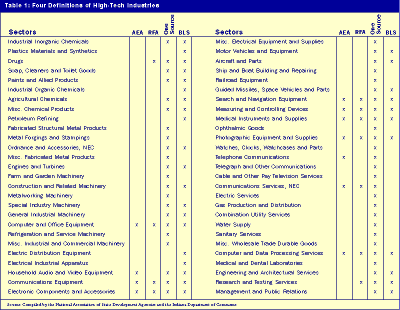
The different missions of these four organizations influence how they define high-tech. AEA is a trade association made up of mostly electronics and information technology companies. Its members generally produce technology and ascribe to the limited definition of high-tech based only on the nature of an industry's product rather than its process. RFA is a national consulting firm. Its clients include builders and contractors, banks, insurance companies, financial services firms and government. The industries with the greatest growth potential and those reflective of their clients' interests are included in RFA's list of high-tech industries. While both AEA and RFA have narrowly defined high-tech, One Source and BLS use broader definitions that include industries with both high-tech products and processes.
One Source gathers and sells corporate information on technology firms for use in sales and marketing. As it has built its database of firms, One Source has expanded its list of what should be considered a high-tech industry. BLS is a federal agency responsible for collecting and analyzing data on the national labor force. It has defined those industries with the highest concentration of technology-based occupations, such as scientists and engineers, as high-tech industries.
Combining these four definitions, Figure 1 compares high-technology employment growth in Indiana and the United States.
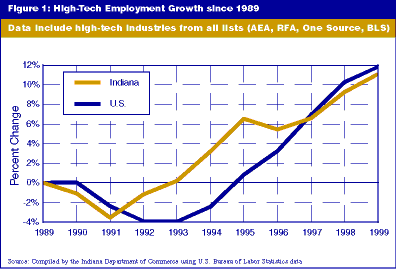
Using 10 years of BLS data (1989 to 1999), we can illustrate how different definitions of high-tech can show vastly different results (see Table 2 and Figure 2). The data are sorted at the three-digit SIC level.
Click on table to see larger version.
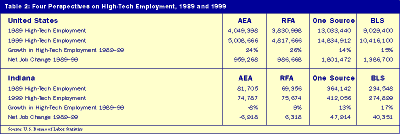
The Trade Association: AEA
AEA recently released Cyberstates 4.0, its annual report on technology employment, based on AEA's limited definition of high-tech industries, which fall into three categories: 1) computer, communication, and electrical equipment, 2) communication services and 3) computer related services.
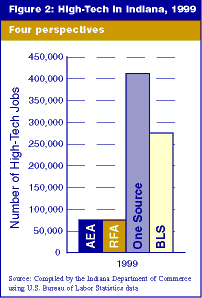
AEA's list is the most restrictive of the four classifications. Absent from the list are areas such as drug manufacturing, robotics, and research and testing operations. Using the AEA classification, total U.S. high-tech employment grew 24% since 1989, while Indiana sustained a loss of 8% (approximately 7,000 jobs).
The AEA results for Indiana, however, clearly illustrate the vagaries of high-tech classifications. AEA's results are largely dictated by employment changes in Indiana's household audio and video equipment sector. This is in part due to global markets drawing plants to less-expensive labor markets. However, in Indiana, reclassification of companies had a much greater impact during the period being reported. The largest reclassification occurred in 1995 when Delphi Delco Electronics Systems in Kokomo was moved out of electronics and into motor vehicles by BLS. Delphi Delco-Kokomo produces the Electronic Powertrain Control Module, which incorporates state-of-the-art computer technology to measure and control the engine and automatic transmission. With this reclassification, the approximately 9,500 high-skill jobs designing and producing automotive electronics were no longer reflected in the AEA results. Without this reclassification, Indiana would have added 2,582 high-tech jobs for a growth rate of 3.2% versus the decline shown in the AEA study. According to AEA, Indiana's strongest high-tech industry, in terms of growth, is computer and data processing services.
The Consulting Group: RFA
RFA's high-tech sectors are similar to those selected by AEA. However, RFA does not include household audio and video equipment or telephone communications, but adds drugs and research and testing services.
Under RFA's classification, Indiana's high-tech employment shows a net increase of more than 6,000 jobs since 1989, whereas AEA showed a net loss of approximately the same amount for the same time period. According to RFA, Indiana high-technology sector employment has increased every year except one since 1995. By changing just two industries, RFA data paint a far rosier picture of Indiana's high-tech economy than AEA data.
Information Provider: One Source
Unlike the short lists compiled by AEA and RFA, the One Source list classifies
48 sectors as high-tech. Major additions include a number of manufacturing
industries, such as metal products and transportation equipment, and several
service industries.
Using a list with such a diverse collection of industries, high-tech in Indiana
takes on a much different appearance. Under the One Source definition, Indiana
has a greater share of employment in high-tech sectors than the United States
and an employment growth rate nearly equal to the U.S. rate. Indiana does
best in the manufacturing sectors, showing gains in 22 of 33 sectors with
a net increase of 31,287 jobs between 1989 and 1999. Motor vehicle and equipment
employment represents the largest share of employment growth (includes firms
previously coded under electronics).
Even excluding manufacturing, Indiana still had a net gain of 15,364 jobs, mostly concentrated in computer and data processing services and business services. Both the engineering and architectural services and management and public relations sectors showed strong growth, gaining more than 11,500 jobs.
The Research Group: BLS
As with One Source, Indiana does quite well using the BLS sectors. Since 1989, Indiana has seen a net gain of more than 40,000 jobs and a growth rate of 17%, exceeding the U.S. rate of 15%. Indiana accounts for 2.6% of national employment for these sectors. High-tech service industries are fastest-growing in Indiana and the nation (see Figure 3).
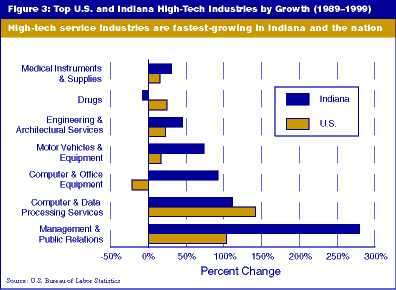
BLS has further refined its high-tech industry definition by separating sectors into two groups. Those industries with a high concentration of research-oriented occupations are labeled intensive, while those with a lower concentration are considered non-intensive. This two-tiered structure illustrates Indiana's strength in industries using high-tech processes over those producing high technology. Like Indiana, the nation has grown faster in non-intensive industries (18%), but has also performed well in the intensive sectors (13%) since 1989. In Indiana, the motor vehicle industry is the powerhouse of the non-intensive category, while computer and data processing services are the strongest intensive high-tech industries.
The differences shown here illustrate why knowing how data are defined is essential to understanding what the data mean. Once again, those wishing for a simple answer will be frustrated. It is not the data that have failed them, but the reality of a complex system (the economy) and the human factor that must determine how to best reflect that system using data.
